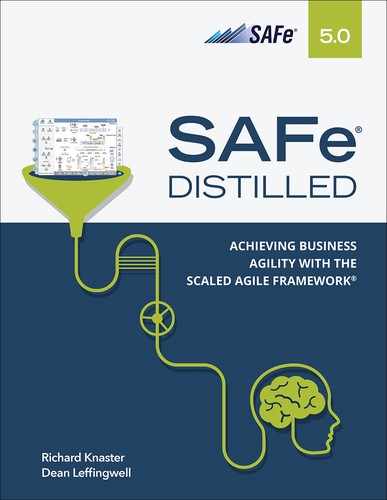4
SAFe Principles
“The impression that ‘our problems are different’ is a common disease that afflicts management the world over. They are different, to be sure, but the principles that will help to improve the quality of product and service are universal in nature.”
—W. Edwards Deming
Why Focus on Principles?
The Scaled Agile Framework (SAFe) is based on a set of Lean-Agile principles—the core beliefs, fundamental truths, and economic values that drive effective roles and practices. It is based on principles because they are enduring. No matter the situation, they stand the test of time and can be applied universally. Principles inform SAFe practices—a specific activity, action, or way of accomplishing something.
But a practice that works in one situation may not necessarily apply or work in another. Therefore, before an enterprise can apply SAFe practices, it requires an understanding of its underlying principles. This chapter describes the following SAFe Lean-Agile principles:
Take an economic view.
Apply systems thinking.
Assume variability; preserve options.
Build incrementally with fast, integrated learning cycles.
Base milestones on objective evaluation of working systems.
Visualize and limit Work In Process (WIP), reduce batch sizes, and manage queue lengths.
Apply cadence; synchronize with cross-domain planning.
Unlock the motivation of knowledge workers.
Decentralize decision-making.
Organize around value.
Principle #1: Take an Economic View
“While you may ignore economics, it won’t ignore you.”
—Don Reinertsen, Principles of Product Development Flow
Delivering the best value and quality for people and society in the shortest sustainable lead time requires a fundamental understanding of the economics of building systems. Everyday decisions must be made in a proper economic context. Two Lean-Agile practices are essential to this principle: to deliver incrementally, early, and often, and to apply a comprehensive economic framework.
Deliver Early and Often
Most organizations embrace Lean-Agile development because their existing processes aren’t producing the results they need, or because they anticipate that they won’t work in the future. By choosing a Lean-Agile path, they’re embracing a model based on incremental development and early and continuous value delivery, as Figure 4-1 illustrates.

Figure 4-1. Moving to early and continuous delivery of value
The ability to deliver early and often has a direct economic benefit, as illustrated in Figure 4-2.
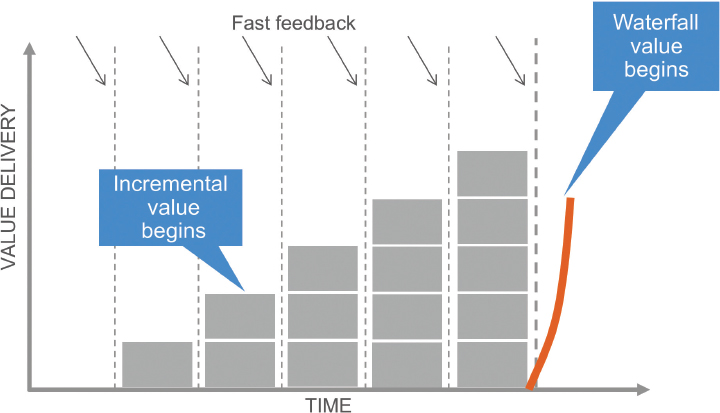
Figure 4-2. The accumulating value of incremental delivery
This figure shows how Lean-Agile methods deliver value to the customer much earlier in the process and accumulate additional value over time. Conversely, with the waterfall model, value can’t even begin to accrue until the end of the development cycle. Also, the figure above doesn’t even take into account the advantage of far faster feedback or the probability that the waterfall delivery would not occur on time. Simply put, even a perfectly executed waterfall project (and there aren’t so many of those) can’t compete economically with an Agile approach.
Moreover, as long as the quality is high enough, products and services offered to the market early are typically more valuable than if they were delivered later. After all, if they arrive ahead of the competition, products are worth a premium as they aren’t available from anyone else. Even a Minimum Viable Product (MVP) can be worth more to an early buyer than a more full-featured product delivered later.
Apply a Comprehensive Economic Framework
Every SAFe portfolio requires an economic framework—a set of decision guidelines that align everyone with the financial objectives of a portfolio and inform the decision-making process. After all, teams and Agile Release Trains (ARTs) make many decisions every day, influencing economic outcomes. Without proper guidance, self-organizing teams will just make their ‘best guess.’ As a result, teams may make choices that are not aligned with the core economics of the system, creating the potential for technical debt, rework, waste, and a lack of fitness for use.
SAFe’s economic framework contains these four primary elements:
Operating within Lean budgets and guardrails. These guardrails include guiding investments by horizon, optimizing value and solution integrity with capacity allocation, approving significant initiatives (portfolio epics), and continuous business owner engagement.
Understanding economic trade-offs. Everyone involved in building solutions needs to understand the trade-offs between development expense, lead time, product cost, value, and risk. Changing any one of these five variables can have an impact on one or more of the others. Understanding how each variable influences the others is vital to making good decisions.
Leveraging suppliers. Outsourcing labor can provide a cost-efficient way to add personnel, especially if the need is temporary or the demand is highly variable. A supplier may provide specific hardware, software, or skills needed for the solution.
Sequencing jobs for the maximum benefit. In a flow-based system, job sequencing, rather than prioritization based on speculative return on investment, produces the best economic outcome. To that end, Weighted Shortest Job First (WSJF) is used to prioritize backlogs by calculating the relative Cost of Delay (CoD) and job duration.
Principle #2: Apply Systems Thinking
“A system must be managed. It will not manage itself. Left to themselves, components become selfish, independent profit centers and thus destroy the system ... The secret is cooperation between components toward the aim of the organization.”
—W. Edwards Deming
Deming observed that addressing the challenges in the workplace and the marketplace requires an understanding of the systems within which workers and users operate. Such systems are complex, and they consist of many interrelated components. But optimizing a component does not optimize the system. To improve, everyone must understand the larger aim of the system. In SAFe, systems thinking is applied to the solution being developed, and the organization that builds the system.
Figure 4-3 illustrates the three primary aspects of systems thinking.

Figure 4-3. Aspects of systems thinking
Understanding these concepts helps leaders and teams navigate the complexity of solution development, the organization, and the larger picture of total time to market. Each aspect is described in the following sections.
The Solution Is a System

Each value stream produces one or more solutions, which are the products, services, or systems delivered to internal or external customers. When it comes to these systems, Deming’s quote that “a system must be managed” leads to these critical insights:
Team members should clearly understand the boundaries of the system and how it interacts with the environment and the systems around it.
Optimizing a solution component does not optimize the system as a whole.
The value of a system passes through its interconnections.
A system can evolve no faster than its slowest integration point.
The Enterprise Building the System Is a System, Too

There’s a second aspect to systems thinking: the people, management, and processes of the organization that develop the system are also a system. The understanding that systems must be managed applies in this case as well. Otherwise, the components of the organization building the system will optimize locally and become selfish, limiting the speed and quality of value delivery. While these insights apply directly here, there is more to consider:
Since building systems is a social endeavor, leaders should create an environment where people can collaborate on building better systems.
Suppliers and customers are integral to the value stream. They need to be treated as partners, based on a long-term foundation of trust.
Optimizing individual teams or functional departments does not necessarily enhance the flow of value through the enterprise.
Accelerating value flow requires eliminating silos and creating cross-functional organizations, such as ARTs and Solution Trains.
Understand and Optimize the Full Value Stream

Value streams are fundamental to SAFe. A SAFe portfolio is a collection of development value streams, each of which delivers one or more solutions to the market. Each value stream (Figure 4-4) consists of the steps necessary to integrate and deploy a new concept through a new or existing system.

Figure 4-4. A value stream from ‘concept to cash’
Understanding and optimizing the full value stream—the third aspect of systems think-ing—is the only way to reduce the total time it takes to go from concept to cash.1
1. Mary Poppendieck and Tom Poppendieck, Implementing Lean Software Development (Addison-Wesley, 2006).
Only Management Can Change the System
“Everyone is already doing their best; the problems are with the system … only management can change the system.”
—W. Edwards Deming
This Deming quote prepares us for a final set of insights. Systems thinking requires a new approach to management as well. Lean-thinking managers are systematic problem-solvers, who take the long view, proactively eliminate impediments, and lead the changes necessary to improve the systems that limit performance. They exhibit and teach systems thinking and Lean-Agile values, principles, and practices. Moreover, such leaders foster a continuous learning culture that includes relentless improvement in the application of systems thinking.
Principle #3: Assume Variability; Preserve Options
“Generate alternative system-level designs and subsystem concepts. Rather than try to pick an early winner, aggressively eliminate alternatives. The designs that survive are your most robust alternatives.”
—Allen C. Ward, Lean Product and Process Development
Traditional design and life-cycle practices encourage choosing a single design-and-requirements option too early in the development process. Unfortunately, if that starting point proves to be the wrong choice, then future adjustments take too long and can lead to a suboptimal outcome.
Figure 4-5 contrasts a traditional point-based design against a Set-Based Design (SBD) approach. In SBD, developers consider multiple design choices at the start. After that, they continuously evaluate economic and technical trade-offs—based on the objective evidence demoed at integration-based learning points. Then they eliminate the weaker options over time and ultimately converge on a final design, based on the knowledge gained to that point. The results of this approach are better designs and economic outcomes.
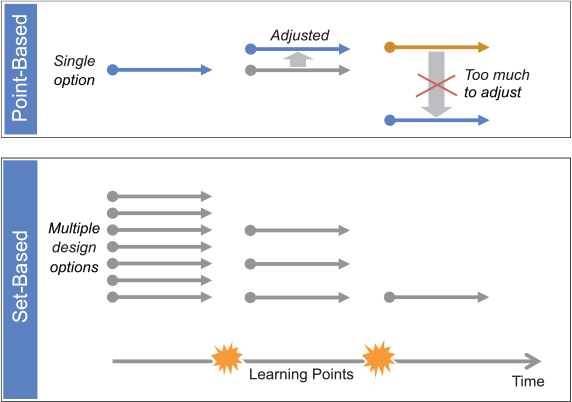
Figure 4-5. Moving to early and continuous delivery of value
Principle #4: Build Incrementally with Fast, Integrated Learning Cycles
“The epiphany of integration points is that they control product development and are the leverage points to improve the system. When the timing of integration points slips, the project is in trouble.”
—Dantar P. Oosterwal, The Lean Machine
In traditional, phase-gated development, investment costs begin immediately and accumulate until a solution is delivered. Often, little to no actual value is provided before all of the committed features are available or the program runs out of time or money. What’s more, the development process itself isn’t set up or implemented to allow incremental capabilities to be evaluated by the customer. As a result, the risk remains until the end of the project when feedback can finally be obtained on the feature’s fitness for purpose.
Integration Points Create Knowledge from Uncertainty
Lean principles and practices approach the problem differently by starting with a range of requirements and design options (Principle #3), which are considered while building the solution incrementally in a series of short timeboxes (iterations). Each iteration results in an increment of a working system that can be evaluated. Subsequent ones build on the previous increments, and the solution evolves until it’s released. The knowledge gained from integration points helps establish technical viability, and can also serve as minimum viable solutions or prototypes for testing the market, validating usability, and obtaining objective customer feedback.
Integration Points Occur by Intent
The development process and the solution architecture must both be designed for frequent integration points. Each point creates a ‘pull event’ that pulls the various solution elements into an integrated whole, even though it addresses only a portion of the system intent. Integration points pull the stakeholders together as well, creating a routine synchronization that helps assure that the evolving solution addresses the real and current business needs, as opposed to the assumptions established at the beginning. Each integration point delivers its value by converting uncertainty into knowledge.
Faster Learning Through Faster Cycles
Figure 4-6 illustrates how integration points reinforce the basic Plan–Do–Check–Adjust (PDCA) scientific learning process, which helps control the variability of solution development. Like science, the system advances one cycle at a time.
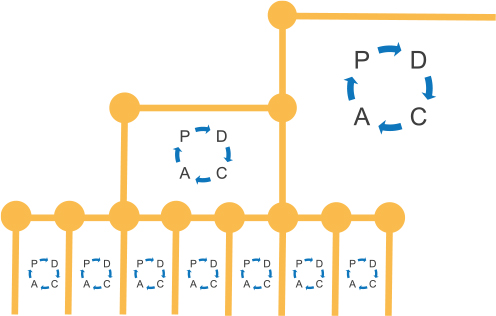
Figure 4-6. Nested integration points occur by intent using a fixed cadence
Moreover, the more frequent the integration points, the faster the learning. In complex systems development, local integration points are used to assure that each system element or capability is meeting its responsibilities to contribute to the overall solution intent. These local points are then integrated at the next higher system level. The larger the system, the more such integration levels exist. The more frequent it happens the faster you learn.
Principle #5: Base Milestones on Objective Evaluation of Working Systems
“There was, in fact, no correlation between exiting phase gates on time and project success ... the data suggested the inverse might be true.”
—Dantar P. Oosterwal, The Lean Machine
Building today’s large-scale systems requires substantial financial investment. Business Owners, customers, and developers need to collaborate to ensure that the proposed return on investment is consciously addressed throughout the development process, rather than hoping that everything will work out in the end.
However, as shown in Figure 4-7, the sequential, phase-gated development process that so many companies rely on to assess progress, reduce risk, and manage investment exposure doesn’t always work that way. That’s because this model has inherent flaws. The phase-gate model assumes that a point (known) solution exists, and requirements will not change as development occurs. Worse, in most cases, there isn’t even a partial working solution available at the phase gates to demonstrate actual progress. As a result, real progress isn’t known until the end, when the solution is integrated and tested, which often results in significant rework and delays.
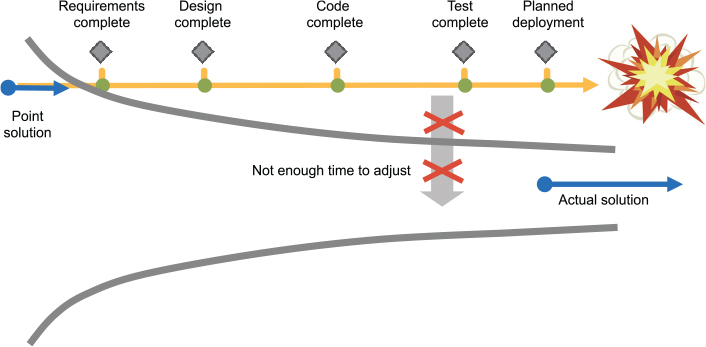
Figure 4-7. The problem with phase-gate milestones
Base Milestones on Objective Evidence
Unlike the phase-gated model, development milestones in SAFe involve a portion of each step—requirements, design, development, testing—together producing an increment of value. Further, this is done routinely on a cadence, which provides the discipline needed to ensure periodic availability and evaluation, as well as predetermined time boundaries that can be used to collapse the field of less desirable options.
What is measured at these critical integration points is subject to the nature and the type of system being built. But the point is that the system can be objectively measured, assessed, and evaluated by the relevant stakeholders frequently throughout the solution development life cycle. This evaluation provides the financial, technical, and fitness-for-purpose governance needed to ensure that continued investment makes economic sense.
Principle #6: Visualize and Limit WIP, Reduce Batch Sizes, and Manage Queue Lengths
“Operating a product development process near full utilization is an economic disaster.”
—Donald Reinertsen
To achieve the shortest sustainable lead time, Lean enterprises strive for a state of continuous flow, which allows them to move new system features quickly from concept to cash. This flow requires a sufficient capacity of people and resources to respond to unforeseen events. In addition to capacity, there are three primary keys to implementing flow, each of which are described in the following sections.
Visualize and Limit WIP
Overloading teams and ARTs with more work than can be reasonably accomplished causes too much WIP, which confuses priorities, causes frequent context switching, and increases overhead and wait times. Like a crowded highway at rush hour, there is simply no upside to having more WIP than the system can handle. Experience shows that excess WIP drives high utilization, which results in the inability to respond to change, burnout, late product launches, reduced profits, and poor economic outcomes.
The first step to correct the problem is to make the current WIP visible to all stakeholders. The simple Kanban board in Figure 4-8 provides one example of how to do this.

Figure 4-8. Example Kanban board
Kanban boards show the total amount of work for each development state and help identify bottlenecks. In some cases, simply visualizing the work helps address the problems of starting too much work and not finishing enough. When any state reaches its WIP limit, no new work is started until the bottleneck is addressed, which significantly increases flow. Establishing WIP limits balances the demand against the available capacity.
Reduce Batch Size
Another way to improve flow is to decrease the batch sizes of the work. Small batches flow through the system faster and with more predictability, which results in more rapid learning and value delivery. As Figure 4-9 illustrates, the economically optimal batch size depends upon both the holding cost (of inventory and of delaying feedback and value) and the transaction cost (of planning, implementing, and testing the batch).

Figure 4-9. Total cost is the sum of the transaction and holding costs
To improve the economics of smaller batches and to increase throughput and reliability, it’s essential to reduce the transaction costs. This cost reduction typically involves more investment in infrastructure and test automation, including practices such as continuous integration, test-driven development, and DevOps.
Manage Queue Lengths
The last insight to improve flow is to manage and reduce the length of the work queue. Long queues of work create all sorts of undesirable results.
Longer cycle times. New work entering the queue takes longer to complete.
Increased risk. The value of items in the queue, such as requirements, decays over time.
Increased variability. Each item has some variability, and the more items, the more overall variability.
Lower motivation. A large queue of work lowers the sense of urgency.
In contrast, reducing queue length decreases delays, reduces waste, and increases the quality and predictability of outcomes. Little’s law—the fundamental law of queuing theory—tells us that the average wait time for an item in the queue is equal to the average queue length, divided by the average processing rate.
The line to buy coffee at Starbucks teaches us that the longer the queue, the longer the wait. It also tells us that there are only two options to decrease wait times: reduce the length of the queue (e.g., open more lines) or increase the processing rate (make coffee faster). Increasing the processing rate—doing things more quickly—is indeed beneficial, but improvements in processing rates may reach their limits before they truly impact throughput. So, the fastest way to reduce wait times is to reduce the length of the queue. Keeping backlogs short and largely uncommitted facilitates accomplishing this goal. Visualizing the backlog also helps immensely.
By combining the three elements of visualizing and limiting WIP, reducing batch sizes, and managing queues, measurable improvements in throughput, quality, customer satisfaction, and employee engagement are possible.
Principle #7: Apply Cadence; Synchronize with Cross-Domain Planning
“Cadence and synchronization limit the accumulation of variance.”
—Donald Reinertsen
Solution development is an inherently uncertain process. If it weren’t, the solutions would already exist, and there would be no room for the next generation of innovations. This uncertainty conflicts with the need for businesses to manage investments, track progress, and have sufficient confidence in future outcomes to plan and commit to a reasonable course of action.
Agile development functions best in a ‘safety zone,’ where enough uncertainty provides the freedom to pursue innovation and react to events, while also giving confidence the business needs to operate. The primary means to achieve this balance is through the objective knowledge of the current state. This knowledge is gained by applying cadence and synchronization, coupled with cross-domain planning.
Cadence makes routine everything that can be routine so teams can focus on managing the variable parts of solution development.
Synchronization allows multiple solution perspectives to be understood, resolved, and integrated at the same time.
Figure 4-10 highlights many of the benefits of cadence and synchronization.

Figure 4-10. Benefits of cadence and synchronization
Taken together, cadence and synchronization help development teams proceed confidently despite the inherent uncertainty.
Align Development Cadence
Figure 4-11 illustrates that each team is ‘sprinting’ on the same cadence, allowing multiple teams to evolve, integrate, and demo the solution on a predictable schedule. This improves alignment, communication, coordination, and integration.
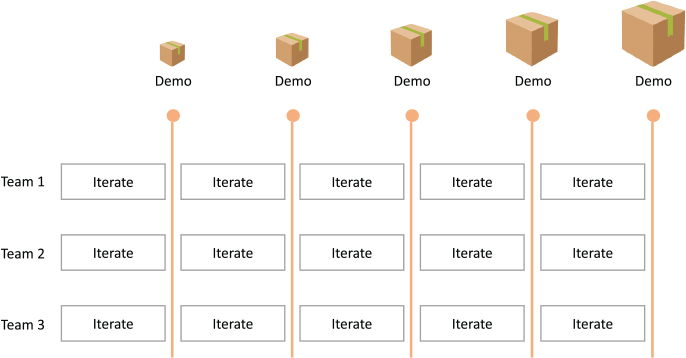
Figure 4-11. Common cadence supported by regular system demos
However, Reinertsen notes that ‘delivering on cadence’ is another matter entirely, one that requires scope or capacity margin (buffer). ARTs need to be careful about planning to meet date-based commitments, which requires some scope or capacity margin—something that you’ll see in many elements of the SAFe PI planning and commitment processes.
Synchronize with Cross-Domain Planning
In addition to common cadence, periodic cross-domain planning (Program Increment [PI] planning) provides the opportunity for the various aspects of a solution—business and technical—to be integrated and evaluated together at one time. This helps teams manage variability by frequently revisiting and updating the plan. In other words, cadence-based planning limits variability to a single time interval (Figure 4-12).
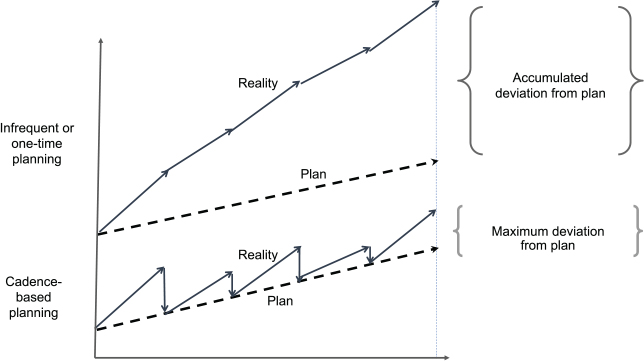
Figure 4-12. Cadence-based planning limits variability
PI planning is essential to SAFe and serves three primary purposes.
A milestone to assess the current state of the solution
Realigns all stakeholders to a shared technical and business vision
The teams plan and commit to the next PI
With synchronized cross-domain planning, the business has a current ongoing plan that leads to the appropriate actions. Also, the development of large-scale systems is fundamentally a social activity. This planning event provides an opportunity to create and improve the social network that builds the solution. Taken together, cadence and synchronization—and the associated activities—help reduce uncertainty and manage the variability inherent in solution development.
Principle #8: Unlock the Intrinsic Motivation of Knowledge Workers
“Knowledge workers are people who know more about the work they perform than their bosses.”
—Peter Drucker2
2. Peter F. Drucker, The Essential Drucker (Harper-Collins, 2001).
Drucker’s definition of a knowledge worker causes us to question how managers can seriously attempt to supervise, outthink, and coordinate the technical work of a large number of people who know more about the system than they do. Simply put, they can’t. Instead, it’s far more beneficial for management to focus on unlocking the intrinsic motivation of knowledge workers, as described by the examples in the next four sections.
Leverage Systems Thinking
Leveraging systems thinking allows knowledge workers to see the whole picture, communicate across functional boundaries, make decisions based on an understanding of solution economics, and receive fast feedback about the viability of their solutions. They can participate in continuous, incremental learning and mastery, and they can contribute to a more productive and fulfilling solution development process.
Understand the Role of Compensation
Many organizations still embrace outdated assumptions about human potential and individual work performance. Despite mounting evidence that short-term incentives and pay-for-performance plans don’t work and often do harm, they continue to apply these and similar measures. Authors as varied as Pink3 and Drucker4 have highlighted the core paradox of compensation for knowledge workers: If you don’t pay people enough, they won’t be motivated. But after a certain point, adding incentive compensation can shift the focus to the money, rather than the work, resulting in worse employee performance. Lean-Agile leaders understand that neither money nor the reverse—threats, intimidation, or fear—inspires ideation, innovation, and deep workplace engagement. Specifically, monetary incentives based on individual objectives may cause harmful internal competition and destroy the cooperation needed to achieve the broader aim.
3. Daniel Pink, Drive: The Surprising Truth About What Motivates Us (Riverhead Books, 2011).
4. Peter F. Drucker, The Essential Drucker (Harper-Collins, 2001).
Create an Environment of Mutual Influence
An environment of mutual influence fosters motivation and empowerment. Leaders create an environment of mutual influence by giving honest feedback supportively, showing a willingness to become more vulnerable, and encouraging others to do the following:5
Disagree when appropriate
Advocate for the positions that represent their beliefs
Make their needs clear and push to achieve them
Enter into joint problem-solving, with management and peers
Negotiate, compromise, agree, and commit
5. David L. Bradford and Allen Cohen, Managing for Excellence: The Leadership Guide to Developing High Performance in Contemporary Organizations (John Wiley and Sons, 1997).
Provide Autonomy with Purpose, Mission, and Minimum Possible Constraints
Daniel Pink’s work, and the work of many others, helps us understand that there are three primary factors in establishing deep workplace engagement.6
Autonomy is the desire to self-direct or to manage one’s own life. When it comes to knowledge work, self-direction is better.
Mastery is the inherent need for people to grow in their careers and acquire new skills that allow them to provide ever higher levels of contribution.
Purpose is the need to make a connection between the aim of the enterprise and the worker’s daily activities. This makes the work more meaningful and links the worker’s personal goals to the company mission.
6. Daniel Pink, Drive: The Surprising Truth About What Motivates Us (Riverhead Books, 2011).
Lean-Agile leaders need to understand these concepts and strive to continuously create an environment where knowledge workers can do their best work.
Principle #9: Decentralize Decision-Making
“Knowledge workers themselves are best placed to make decisions about how to perform their work.”
—Peter F. Drucker
Delivering value in the shortest sustainable lead time requires decentralized decision-making. Any decision escalated to higher levels of authority introduces a delay, which can decrease the effectiveness of the decision-making process. Decentralized decision-making, in contrast, has the benefit of local context and reduces delays and improves product development flow. It enables faster feedback, more innovative solutions, and higher levels of empowerment.
Centralize Strategic Decisions
Of course, not every decision should be decentralized. Some decisions are strategic, have far-reaching impact, and are largely outside of the team’s areas of knowledge and responsibility. This leads us to conclude that some decisions should be centralized. Generally, these types of decisions have the following characteristics:
Infrequent. These decisions aren’t made often and typically aren’t urgent. Thus, deeper consideration is appropriate.
Long-lasting. Once reached, these decisions are unlikely to change.
Provide significant economies of scale. These decisions provide large and broad economic benefits.
Leadership is charged with making these types of decisions, supported by the input of those impacted by the decisions.
Decentralize Everything Else
However, most decisions do not reach the threshold of strategic importance. Therefore, all other decisions should be decentralized. The people who have better local context and detailed knowledge of the technical complexities of the current situation should make these decisions. These types of decisions typically meet the following criteria:
Frequent. These decisions are common and occur often.
Time critical. A delay in these types of decisions comes at a high cost.
Require local information. These decisions need specific local context.
Principle #10: Organize Around Value
“The world is now changing at a rate at which the basic systems, structures, and cultures built over the past century cannot keep up with the demands being placed on them. Incremental adjustments to how you manage and strategize, no matter how clever, are not up to the job.”
—John Kotter
Many enterprises today are organized around principles developed during the last century, which worked to increase efficiency, predictability, profitability, and competitive advantage. But in today’s digital economy, the only truly sustainable competitive advantage is the speed with which an organization can sense and respond to the needs of its customers. Its strength is its ability to deliver value in the shortest sustainable lead time. Traditional organizational structures “are just not up to the job.” Instead, business agility demands that enterprises organize around value to deliver more quickly. And when market and customer demands change, as they inevitably will, the enterprise has to adapt rapidly and seamlessly to reorganize around that new value flow.
By organizing the enterprise around the flow of value instead of the traditional organizational silos, SAFe provides a second, networked operating system (Figure 4-13). This allows enterprises to focus on both the innovation and growth of new ideas as well as the execution, delivery, operation, and support of existing solutions.
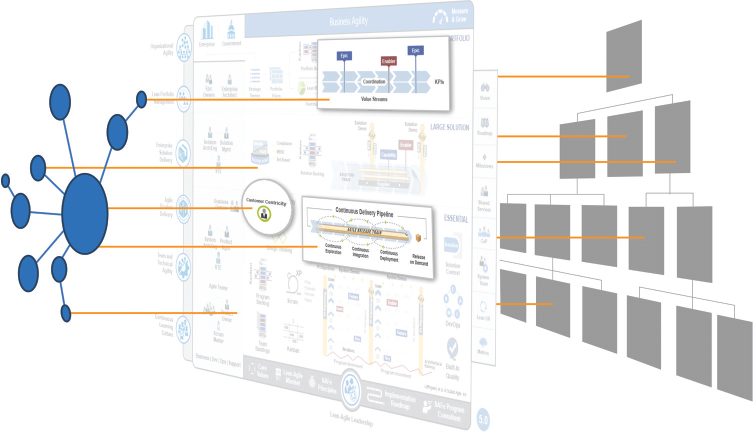
Figure 4-13. A view of SAFe as a second organizational operating system
Understand the Flow of Value
SAFe’s networked operating system is intensely focused on continuous value delivery, requiring the enterprise to organize its portfolios around the flow of value, called ‘value streams.’ A SAFe portfolio is a collection of development value streams, which are connected to deliver more aligned value together. This allows the entire enterprise—from Agile teams to ARTs and from Solutions Trains to the portfolio—to deliver value to the customer in the shortest sustainable lead time. Organizing portfolios around value streams offers substantial benefits to the enterprise, including the following:
Faster learning
Shorter time to market
Higher quality
Higher productivity
Leaner budgeting mechanisms
Furthermore, value stream mapping can be used to identify and address delivery delays, waste, and non-value-added activities.
Realize Value Streams with Agile Teams and Trains
Value streams are realized by the formation of Agile Release Trains (ARTs). Each ART is a team of Agile teams that can define, deliver, operate, and support customer solutions. ARTs work across functional silos and potentially eliminate them. Agile teams are the basic building block of ARTs and are cross-functional, which enables them to define, build, test, and where applicable deploy elements of value quickly with a minimum of handoffs and dependencies (Figure 4-14). In addition, when building extra-large systems, ARTs, along with suppliers, are further organized into Solution Trains, which are designed to deliver even more significant value to the customer.
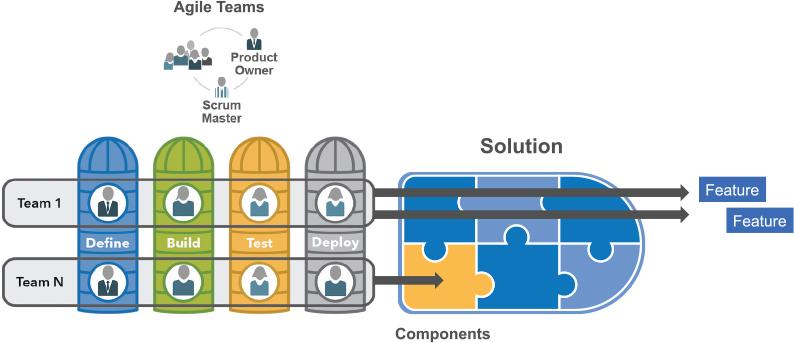
Figure 4-14. Agile teams are cross-functional
Reorganize around Value
While it’s best to keep teams and trains together to foster high performance, the organization must be flexible and adapt when the market, customer needs, or strategy changes. After a while, some solutions may require more or less investment or need to be decommissioned entirely. In short, the solutions in a value stream evolve constantly, and the teams and trains need to evolve with them. The ability of organizations to organize around value, and to reorganize around new flows of value as needed, is a key driver for business agility.
Summary
Fortunately, as Deming notes, “our problems may be different,” but the principles that we can use to address the problems of large-scale software and solution development are universal in nature. SAFe’s ten Lean-Agile principles provide the core beliefs, truths, and economic values that inform the roles and practices of the framework. Before SAFe can be effectively applied, everyone—especially leadership—needs a deep understanding of the principles to know how and why SAFe works. That understanding will create the right knowledge and culture to implement SAFe effectively and, more importantly, to achieve the business benefits that SAFe can provide.
